VoIP Line Properties
Configuring a VoIP Phone Line
In addition to configuring the line properties for a VoIP phone in the Control/Status dialog, configuring the line can also be accomplished by clicking the Line Properties entry under the General section of the Properties sheet. This will open a dialog window where the Line Select buttons can be used to edit the properties of each line.
General Tab
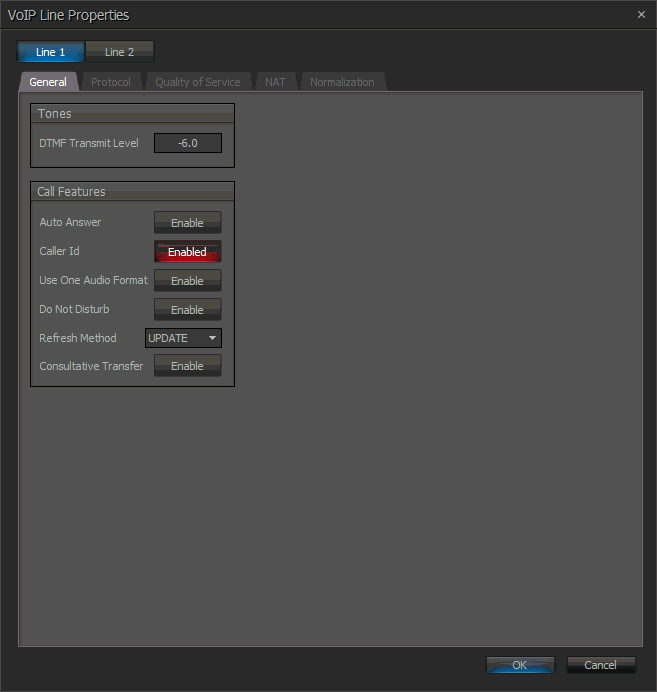
Tones:
DTMF Transmit Level - Sets the volume of outgoing DTMF tones. Range between -100 - 0dB. Default -6.
Call Features:
- Auto Answer - Enables Auto Answer - The Auto Answer Ring Count in the VoIP Control/Status - General / Call features section will specify the number of rings.
- Caller ID - Shows the Caller ID in TTP updates and the Dialer.
- Use One Audio Format - Acknowledges the SIP “invite” with multiple audio format or one audio format.
- Do Not Disturb - Can be enabled or disabled.
- Refresh Method - a Refresh mode of Update or re-INVITE can be specified.
- Consultative transfer - enables consultative transfer mode. when enabled the transfer process will connect the second party to a third party after the third party answers and agrees to take the call (support is dependant on phone system)
Protocol Tab
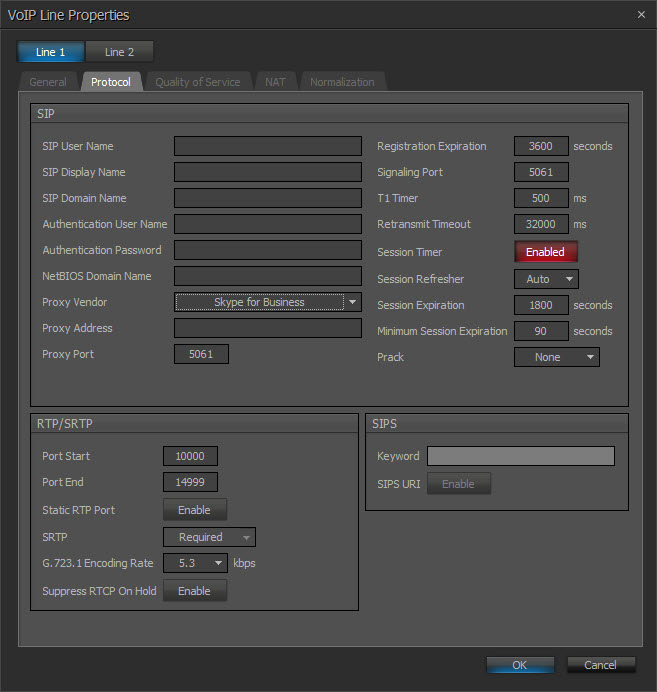
SIP:
- SIP User Name - is the alphanumeric string that identifies the VoIP extension on the network. It is the number or string you would need to dial to reach this extension
- SIP Display Name - is the string used for Caller ID name purposes.
- SIP Domain Name - The SIP domain name to be used.
- Authentication User Name / Authentication Password - the credentials needed to register and authenticate with the VoIP proxy server.
- Proxy Vendor - choose the entry that matches the phone system the VoIP Phone is integrating with. Possible selections are Generic, Avaya SES, Avaya SM, Avaya IP Office, Avaya CS1000, Cisco, Lync, Mitel and ShoreTel. If an exact match does not appear in the list, select Other.
- Proxy Address - the network address of the VoIP proxy server
- Proxy Port - is the network port the VoIP Phone should use to communicate with the proxy server. Port 5060 is a standard port used in VoIP systems, but this number can be modified if need be.
- Registration Expiration - determines the interval the VoIP line will attempt to re-register with the Proxy. Note that the proxy may override this setting with a value of its own. If an acknowledgement has not been received from the Proxy within the agreed time the VoIP card registration information kept in the proxy's database will be cleared. The default registration expiration period is 3600 seconds and should be left at this value unless specified by the network administrator. Can be set between 60 to 86400 seconds.
- Signaling Port - The signaling Port is used to direct incoming SIP traffic to the correct Line for communications between the VoIP card and the Proxy. The default port for Line 1 is 5060 and the default port for Line 2 is 5062. These settings should be left at this value unless specified by the network administrator
- T1 Timer - This timer is used when sending requests over UDP. If the response is not received within this interval, the request is retransmitted. The retransmission interval is doubled after each retransmission.
- Retransmit Timeout - The total amount of time the card will continue to retransmit a UDP packet that has not been responded to.
- Session Timer - Enables periodic refresh of SIP sessions through a Re-INVITE or UPDATE request. When disabled the Session Refresher, Session Expiration and Minimum Session Expiration options will be disregarded. If a call unexpectedly disconnects, disabling this option may help.
Session Refresher in a SIP session that utilizes a session timer, the Session Refresher is the device that will send the periodic Session Refresh requests to refresh the session.
Refresher Options:
Auto - This (Default ) setting allows both ends of the call to negotiate who will be the refresher. Typically this leaves the decision to the device receiving the SIP packets. This setting should be used unless specified otherwise by the network administrator.
UAS - The User Agent Server (UAS) is the VoIP device that responds to the SIP Request. In the case of a phone call it would be considered the “called” device. Engaging this setting will ensure that the SVC-2 card will only negotiate to a Session Timer where the UAS is nominated the refresher.
UAC - The User Agent Client (UAC) is the VoIP device that send the SIP Request. In the case of a phone call it would be considered the “calling” device. Engaging this setting will ensure that the SVC-2 card will only negotiate to a Session Timer where the UAC is nominated the refresher.
Local - This setting will ensure that the SVC-2 card will always be the refresher of a Session Refresh.
Peer - This setting will ensure that the SVC-2 card will never be the refresher of a Session Refresh.
- Session Expiration - Determines the interval the VoIP card will try to negotiate with the Proxy to keep the VoIP session alive. Note that the proxy may override this setting with a value of its own. If a Session Refresh request is not properly received by both parties within this agreed time, the session will expire and the call ended. Can be set between 90 to 65535 seconds, the default is 1800 and should be used unless specified otherwise by the network administrator.
- Minimum Session Expiration - If the proxy tries to override the Session Expiration value as specified in the VoIP card, the time entered in this field will be the minimum value allowed. Can be set between 90 to 65535 seconds, default = 90.
- Prack
- guarantees a reliable and ordered delivery of provisional responses
in SIP. PRACK Improves network reliability
by adding an acknowledgement system to the provisional Responses.
Can be set to None, Supported, Required.
RTP/SRTP:
- Port Start - The first RTP Port used by this line. Must be between 4000 - 65534 and must be one less than the Port End.
- Port End - The last RTP port used by this line. Must be between 4001 - 65535 and must be one more than the Port Start.
- Static RTP Port - Static Real-time Transport Protocol Port - The Port number used for RTP traffic.
- SRTP - Secure Real-time Transport Protocol - Provides encryption of the RTP audio data. Available if Transport is set to TCP or TLS. Go To VoIP Control/ Status Block, open the property sheet DSP properties, Set Protocol SIP-Transport to TCP or TLS. Can be set to Disabled, Allowed, Preferred or Required.
- G.723 Encoding Rate -Defines the G.723 bit rate. The options available are 5.3 and 6.3 kbps.
- Suppress
RTCP On Hold - This parameter determines whether RTCP packets
continue to be sent across the trunk for calls that have been placed
on hold.
SIPS Protocol:
SIPS Keyword - This field is used to enter the keyword used for secure SIP on a per-Line basis. To enable Secure SIP, go To VoIP Control/ Status Block, open the property sheet DSP properties, Set Protocol SIP-Transport to TLS.
Quality of Service (QoS)
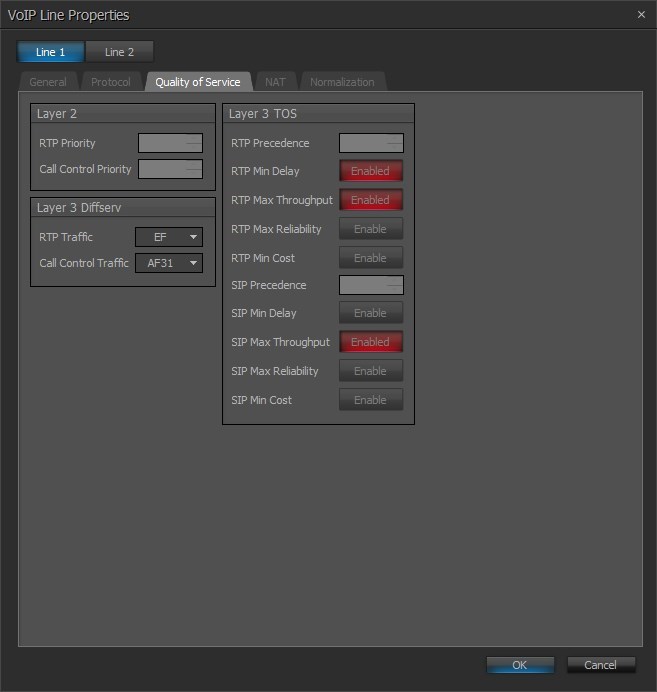
Layer 2:
RTP Priority, Call Control Priority and Other Traffic Priority Quality of Service (QoS) may be set if VLAN is enabled. Numerical priorities 0-3 are low priority; 4-7 are high priority.
Layer 3 DiffServ:
RTP Traffic, Call Control Priority and Other Traffic levels may be set when Layer 3 Mode is set to DiffServ (Differentiated Services).
Layer 3 TOS:
- Allows turning on or off the service variables shown in the screenshot above, as well as level of RTP, SIP and Other Precedence. Numerical priority is set on a range of 0-7, 0 being lowest and 7 being highest. This determines the priority of traffic for the respective type of service.
- Type of Service settings control the efficiency at which data packet traffic is forwarded. Setting the associated switch to On/Off will determine traffic settings of RTP, SIP or Other, respectively:
- Min Delay - data packets will be forwarded with minimum delay.
- Max Reliability - data packets will be forwarded with maximum reliability.
- Max Throughput - data packets will be forwarded with maximum throughput.
- Min Cost - data packets will be forwarded with minimum cost to network bandwidth.
NAT
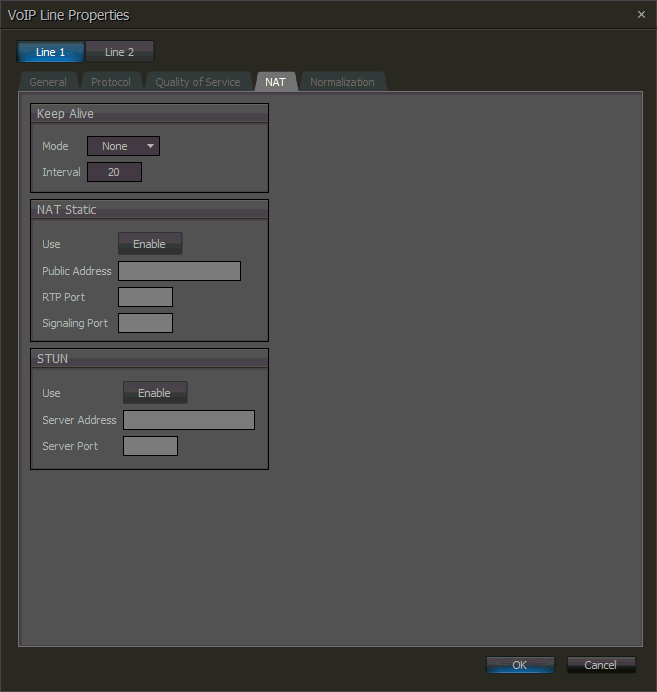
Keep Alive
This feature sends a packet at defined intervals to keep a firewall port open. Mode defines the type of packet sent, and may be set to None, Options, Register or CRLF. If set to anything other than "None," Interval may be set to 20 to 30 seconds; default is 20.
NAT Static and STUN
When NAT Static is enabled, a network admin may allow the VoIP endpoint to use a static port assignment through a firewall. A public address can be entered and an RTP Port and Signaling Port specified. When STUN is enabled, a VoIP endpoint can use an external STUN server to keep firewall ports open. The Server Address and Server Port can be entered in the VoIP configuration. Enabling one of these options disables the other.
Normalization
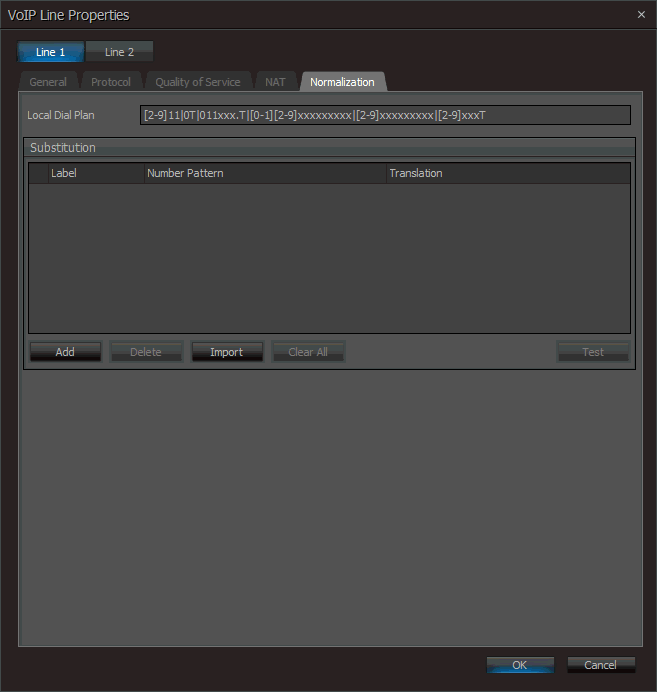
Local Dial Plan is a regular expression which determines dialing behavior according to the method specified in RFC 3435. Use the default Local Dial Plan string unless an alternate one has been provided for you. Default Local Dial Plan: [2-9]11|0T|011xxx.T|[0-1][2-9]xxxxxxxxx|[2-9]xxxxxxxxx|[2-9]xxxT
Substitution:
Microsoft Lync/Skype for Business uses .NET Framework regular expressions to specify numeric match patterns that the server uses to translate dial strings to E.164 format for the purpose of performing reverse number lookup. The substitution dialog allows the definition of similar normalization rules to allow the Tesira VoIP card to automatically translate the dialed digits to E.164 format. Multiple rules can be defined. Each rule includes a label, a matching pattern, and a translation pattern. The rules are based upon lines.
- Add allows the creation of a new rule.
- Delete will remove the selected rule.
- Import allows importing of XML files generated by the Lync Server. Selecting Import brings up an Open File Dialog which enables selection of the generated XML file.
- Clear all will delete all rules.
- Test allows substitution entries to be confirmed. Select the row to test this will bring up a dialog with the selected row’s number pattern and translation rule loaded. Numbers can be added and the translated output verified.
Once substitutions have been added, a right click context menu is available allowing the option to Copy all rows, Copy selected rows or a Paste to bottom function.
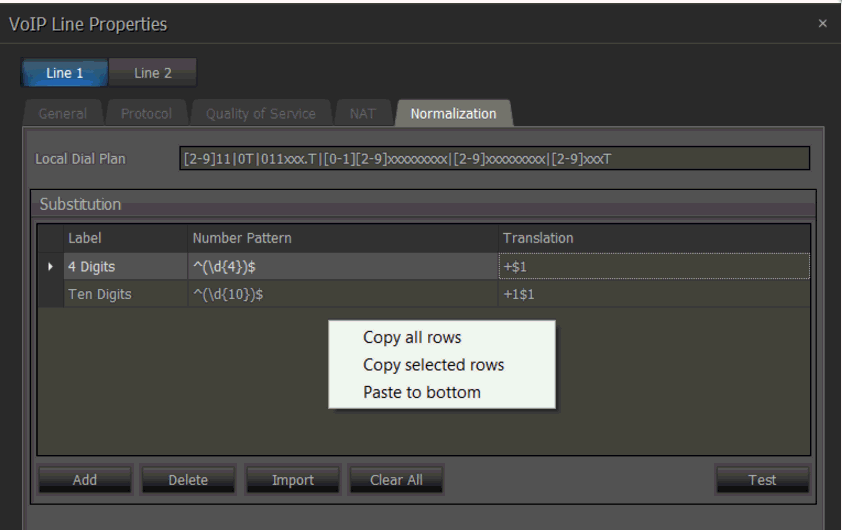
Useful normalization rules
Tesira VoIP follows .Net framework regular expression to create matching rules and is a subset of .Net framework regular expression. Multiple number pattern and translation rules can be created. The number pattern and translation rule must be present as a pair. More details on Normalization can be found here, or by visiting https://support.biamp.com/ and searching normalization.
The below gives some basic information:
- \d - Matches any decimal digit
- ^ - The match must start at the beginning of the string
- $ - The match must occur at the end of the string
- (subexpression) - subexpression
- {n} - Matches the previous element exactly n times
- $number - the substring matched by group number
The table below gives some examples and explanations about the rules.
| Use case | Number pattern | Translation | Example |
| Translates 4-digit extensions | ^(\d{4})$ | +1503718$1 | 1234 is translated to +15037181234 |
| Translates 5-digit extensions starting 5 | ^5(\d{4})$ | +1503718$1 | 51234 is translated to +15037181234 |
| Translates 7-digit numbers | ^(\d{7})$ | +1503$1 | 7189238 is translated to +15037189238 |
| Translates 10-digit numbers | ^(\d{10})$ | +1$1 | 5037189238 is translated to +15037189238 |
| Translates numbers with long distance prefixes | ^1(\d{10})$ | +$1 | 15037189238 is translated to +5037189238 |
| Translates numbers with international prefixes | ^011(\d*)$ | +$1 | 011915037189238 is translated to +915037189238 |
| Translates 0 to an operator | ^0$ | +15037180100 | 0 is translated to +15037180100 |
| Translates numbers with prefixes | ^5678(\d{4})$ | +1503718$1 | 56781234 is translated to +15037181234 |